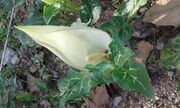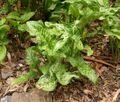Biology:Arum italicum
| Arum italicum | |
|---|---|

| |
| Scientific classification | |
| Kingdom: | Plantae |
| Clade: | Tracheophytes |
| Clade: | Angiosperms |
| Clade: | Monocots |
| Order: | Alismatales |
| Family: | Araceae |
| Genus: | Arum |
| Species: | A. italicum
|
| Binomial name | |
| Arum italicum Mill.
| |
| Synonyms[1] | |
| |
Arum italicum is a species of flowering herbaceous perennial plant in the family Araceae, also known as Italian arum and Italian lords-and-ladies.[2] It is native to the British Isles[3] and much of the Mediterranean region, the Caucasus, Canary Islands, Madeira and northern Africa. It is also naturalized in Belgium, the Netherlands, Austria, Argentina , North Island New Zealand and scattered locations in North America.[1][4][5][6][7]
Description
It grows 30–46 cm (1–1.5 ft) high, with equal spread. It blooms in spring with white flowers that turn to showy red fruit.[2] It is cultivated as an ornamental plant for traditional and woodland shade gardens.[2] Subspecies italicum (the one normally grown in horticulture) has distinctive pale veins on the leaves, whilst subspecies neglectum (known as late cuckoo pint[8]) has faint pale veins, and the leaves may have dark spots.[9] Nonetheless, intermediates between these two subspecies also occur, and their distinctiveness has been questioned.[10][11] Some gardeners use this arum to underplant with Hosta, as they produce foliage sequentially: when the Hosta withers away, the arum replaces it in early winter, maintaining ground-cover.[12] Numerous cultivars have been developed for garden use, of which A. italicum subsp. italicum 'Marmoratum' has gained the Royal Horticultural Society's Award of Garden Merit.[13]
Arum italicum can be invasive in some areas.[12][14][15]
Arum italicum may hybridize with Arum maculatum.[16] The status of two subspecies currently included in Arum italicum, subsp. albispathum (Crimea to the Caucasus) and subsp. canariense (Macaronesia), is uncertain and they may represent independent species.[10]
In 1778, Lamarck noticed that the inflorescence of this plant produces heat.[17][18]
Leaves, fruits and rhizomes contain compounds that make them poisonous. Notably, leaves are rich in oxalic acid; other active principles are present in other parts. The ingestion of berries, which are showy and red, can be fatal for babies and young children, as well as dogs.[citation needed]
Gallery
Taxonomy
Within the genus, A. italicum belongs to subgenus Arum, section Arum.[19]
A. italicum generally has a chromosome count of 2n = 84, except that a few subspecies (such as subsp. albispathum) have 2n = 56.[19]
References
- "Arum italicum". Integrated Taxonomic Information System. https://www.itis.gov/servlet/SingleRpt/SingleRpt?search_topic=TSN&search_value=42544.
- ↑ 1.0 1.1 "Arum italicum Mill.". Plants of the World Online. Royal Botanic Gardens, Kew. https://powo.science.kew.org/taxon/urn:lsid:ipni.org:names:86047-1.
- ↑ 2.0 2.1 2.2 MBG- hort. . accessed 11.1.2011
- ↑ P.A. Stroh; T. A. Humphrey; R.J. Burkmar et al., eds. "Arum italicum Mill.". BSBI Online Plant Atlas 2020. https://plantatlas2020.org/atlas/2cd4p9h.ycz.
- ↑ Govaerts, R. & Frodin, D.G. (2002). World Checklist and Bibliography of Araceae (and Acoraceae): 1-560. The Board of Trustees of the Royal Botanic Gardens, Kew.
- ↑ Castroviejo, S. & al. (eds.) (2008). Flora Iberica 18: 1-420. Real Jardín Botánico, CSIC, Madrid.
- ↑ Dobignard, D. & Chatelain, C. (2010). Index synonymique de la flore d'Afrique du nord 1: 1-455. Éditions des conservatoire et jardin botaniques, Genève.
- ↑ Biota of North America Program, 2013 county distribution map
- ↑ Late cuckoo pint at aphotoflora.com: retrieved 3 October 2020
- ↑ C T Prime (1961). "Taxonomy and Nomenclature in Some Species of the Genus Arum L". Watsonia 5 (2): 106–9. http://archive.bsbi.org.uk/Wats5p106.pdf.
- ↑ 10.0 10.1 Boyce, P.C. (2002). "Arum - a Decade of Change". Aroideana 29: 132–139.
- ↑ Boyce, P.C. (2006). "New Observations on Arum italicum". The Plantsman 5 (1): 36–39.
- ↑ 12.0 12.1 Clark County Master Gardeners
- ↑ "RHS Plant Selector - Arum italicum subsp. italicum 'Marmoratum'". https://www.rhs.org.uk/Plants/92886/Arum-italicum-subsp-italicum-Marmoratum/Details.
- ↑ National Park Service, Exotic Plant Management Team
- ↑ "Invasive Italian arum" (in en-US). https://wmswcd.org/species/italian-arum/.
- ↑ Plantsman v13:3, p142, September 2014; Royal Horticultural Society
- ↑ Meeuse, B.J.D. 1975. Films of liquid crystals as an aid in pollination studies. In Pollination and Dispersal, ed N.B.M. Brantjes, H.F. Linskens, pp 19-20. Nijmegen. The Netherlands: Dep. Botany, Univ. Nijmegen.
- ↑ Wilhelm Pfeffer, The Physiology of Plants: A Treatise Upon the Metabolism and ..., Volume 3
- ↑ 19.0 19.1 Boyce, Peter (1993). The Genus Arum. London: HMSO. ISBN 0-11-250085-4.
External links
- Missouri Botanical Garden - Kemper Center for Home Gardening - Arum italicum
- Invasive Plant Atlas Italian arum - Arum italicum
Wikidata ☰ Q30968 entry
 |







